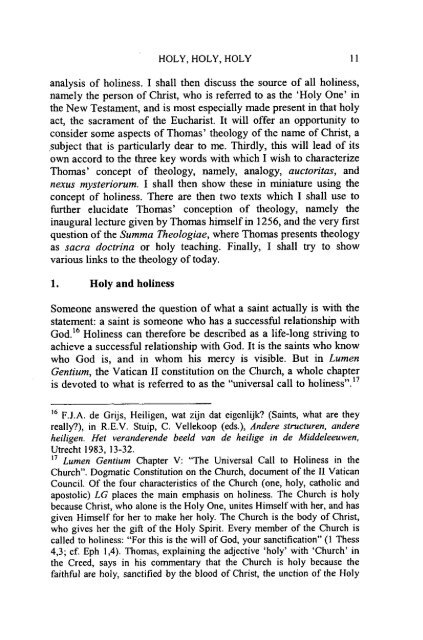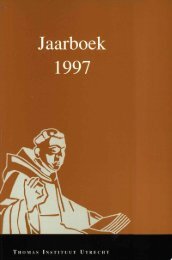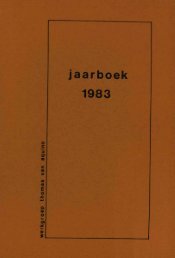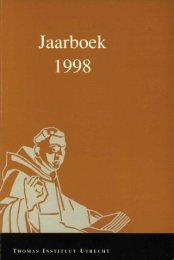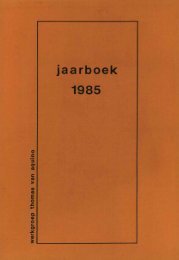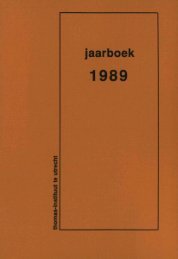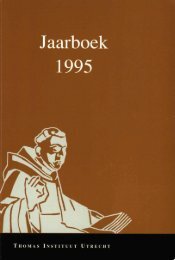Jaarboek Thomas Instituut 2006 - Thomas Instituut te Utrecht
Jaarboek Thomas Instituut 2006 - Thomas Instituut te Utrecht
Jaarboek Thomas Instituut 2006 - Thomas Instituut te Utrecht
You also want an ePaper? Increase the reach of your titles
YUMPU automatically turns print PDFs into web optimized ePapers that Google loves.
HOLY, HOLY, HOLY II<br />
analysis of holiness. I shall then discuss the source of all holiness,<br />
namely the person of Christ, who is referred to as the 'Holy One' in<br />
the New Testament, and is most especially made present in that holy<br />
act, the sacrament of the Eucharist. It will offer an opportunity to<br />
consider some aspects of <strong>Thomas</strong>' theology of the name of Christ, a<br />
subject that is particularly dear to me. Thirdly, this will lead of its<br />
own accord to the three key words with which I wish to charac<strong>te</strong>rize<br />
<strong>Thomas</strong>' concept of theology, namely, analogy, auctoritas, and<br />
nexus mys<strong>te</strong>riorum. I shall then show these in miniature using the<br />
concept of holiness. There are then two <strong>te</strong>xts which I shall use to<br />
further elucida<strong>te</strong> <strong>Thomas</strong>' conception of theology, namely the<br />
inaugural lecture given by <strong>Thomas</strong> himself in 1256, and the very first<br />
question of the Summa Theologiae, where <strong>Thomas</strong> presents theology<br />
as sacra doctrina or holy <strong>te</strong>aching. Finally, I shall try to show<br />
various links to the theology of today.<br />
1. Holy and holiness<br />
Someone answered the question of what a saint actually is with the<br />
sta<strong>te</strong>ment: a saint is someone who has a successful relationship with<br />
GOd.16 Holiness can therefore be described as a life-long striving to<br />
achieve a successful relationship with God. It is the saints who know<br />
who God is, and in whom his mercy is visible. But in Lumen<br />
Gentium, the Vatican II constitution on the Church, a whole chap<strong>te</strong>r<br />
is devo<strong>te</strong>d to what is referred to as the "universal call to holiness".17<br />
16 F.J.A. de Grijs, Heiligen, wat zijn dat eigenlijk? (Saints, what are they<br />
really?), in R.E.V. Stuip, C. Vellekoop (eds.), Andere structuren, andere<br />
heiligen. Het veranderende beeld van de heilige in de Middeleeuwen,<br />
<strong>Utrecht</strong> 1983, 13-32.<br />
17 Lumen Gentium Chap<strong>te</strong>r V: "The Universal Call to Holiness in the<br />
Church". Dogmatic Constitution on the Church, document of the II Vatican<br />
Council. Of the four charac<strong>te</strong>ristics of the Church (one, holy, catholic and<br />
apostolic) LG places the main emphasis on holiness. The Church is holy<br />
because Christ, who alone is the Holy One, uni<strong>te</strong>s Himself with her, and has<br />
given Himself for her to make her holy. The Church is the body of Christ,<br />
who gives her the gift of the Holy Spirit. Every member of the Church is<br />
called to holiness: "For this is the will of God, your sanctification" (I Thess<br />
4,3; cf. Eph 1,4). <strong>Thomas</strong>, explaining the adjective 'holy' with 'Church' in<br />
the Creed, says in his commentary that the Church is holy because the<br />
faithful are holy, sanctified by the blood of Christ, the unction of the Holy


